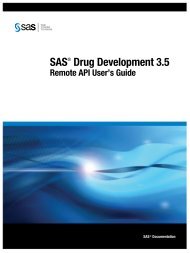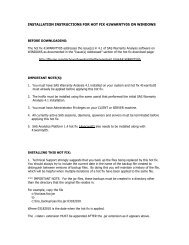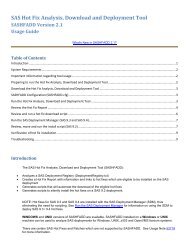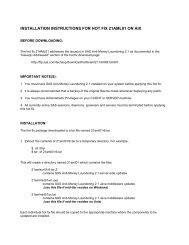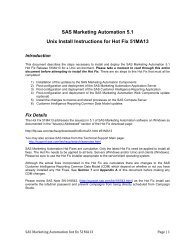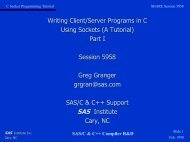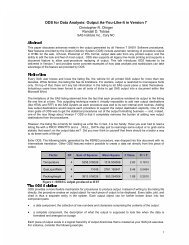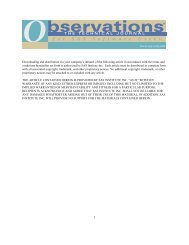%FLATFILE, and Make Your Life Easier - Ftp Sas
%FLATFILE, and Make Your Life Easier - Ftp Sas
%FLATFILE, and Make Your Life Easier - Ftp Sas
- No tags were found...
Create successful ePaper yourself
Turn your PDF publications into a flip-book with our unique Google optimized e-Paper software.
<strong>%FLATFILE</strong>, <strong>and</strong> <strong>Make</strong> <strong>Your</strong> <strong>Life</strong> <strong>Easier</strong>M. Michelle Buchecker, SAS Institute Inc., Chicago, ILABSTRACT<strong>%FLATFILE</strong> is a macro that will create a flat file from a SAS ®data set. This macro takes 3 parameters: the SAS data libraryname, the SAS data set name, <strong>and</strong> the name of the flat file tocreate. The beauty of <strong>%FLATFILE</strong> is that it will query the dataset to determine the variable names <strong>and</strong> write out the PUTstatement INCLUDING the variables' permanent format (or adefault if there is none).Operating Systems: ALLVersion: SAS 6.07 or higherINTRODUCTIONThis paper discusses an easy way to create a fixed column flatfile (ascii file, text file, whatever you want to call it) from a SASdata set. The DATA step provides the mechanism to create aflat file from a SAS data set, but has a few drawbacks. Youmust• know the names of the variables you want to write• specify the format to write for each variable• know how to write the DATA step code• calculate the column widths to ensure there is no overlap.The macro in this paper will do all of the above for you!Let's take an in-depth look at each point <strong>and</strong> see how themacro solves the problem.KNOW THE NAMES OF THE VARIABLES YOU WANT TOWRITEPast SolutionsThis problem is a bit more complex. If you have ever used theCONTENTS procedure or the DATASETS procedure, youknow that either of these two procedures will produce thenames of the variables from a data set in your log or outputwindow. However, the problem is we would like to capturethat information <strong>and</strong> put it inside of our DATA step code.There have been a few macros in the past that have doneexactly that. But, as you can imagine, they were fairlycomplicated, since they had to1. re-direct output to a file2. issue the PROC CONTENTS or PROC DATASETS code3. read the file produced by the procedure4. strip off the unwanted information (of which there wasmuch)5. carefully search for variable names6. store those variable names into macro variables7. write the DATA step.THE DICTIONARY.COLUMNS TABLEStarting with Version 6.07 of the SAS ® System, you now havethe SQL dictionary tables at your disposal. The SQLdictionary tables are essentially data sets about your data sets(<strong>and</strong> catalogs <strong>and</strong> all other SAS files). This macro uses thedictionary table named DICTIONARY.COLUMNS. TheDICTIONARY.COLUMNS table (SQL data sets are calledtables) contains information like• data set name• data set library• variable name• variable type• variable length.There is one row (row is the SQL term for observation) foreach variable in each data set that your current SAS sessionknows about.Selecting Variable Names, Types, Lengths, <strong>and</strong> FormatsThe first step of the macro uses the SQL procedure to readthe DICTIONARY.COLUMNS table for the data set <strong>and</strong> librarythat were supplied as parameters to the macro. Notice theWHERE clause (SQL statements are called clauses sincethere is no semicolon preceding each one). The column name(SQL variables are called columns) LIBNAME is a column inDICTIONARY.COLUMNS referring to a SAS data libraryname. The column name MEMNAME refers to members(data sets) in that data library.By subsetting DICTIONARY.COLUMNS based on the library<strong>and</strong> data set, you obtain information just on that data set. Theselect clause extracts just the• column name (NAME)• column type (TYPE)• column format (FORMAT)• column length (LENGTH).Remember, there is one row (observation) for each column(variable). These results are then stored in the SAS view (dataset) WORK.TEMP.Creating Macro Variables for Variable Names <strong>and</strong> Formats The DATA step reads the data set created by PROC SQL<strong>and</strong> creates a series of macro variables named• VAR1-VARn• FMT1-FMTn.n is the total number of variables in the data set.To create these macro variables, CALL SYMPUT is used.CALL SYMPUT takes two arguments. The first argument isthe name of the macro variable to create. The secondargument is the value the macro variable will contain. Forexample, we want the value of the first macro variable, VAR1,to be the name of the first variable in the data set you want towrite out. The macro variable FMT1 is that variables'permanent format. If the variable does not have a permanentformat, a format of BEST10. is assigned. Since we know the macro variable name always starts withVAR, the word VAR is enclosed in quotes because it isconstant. Next, we have to append a number/counter. TheDATA step automatically contains a variable called _N_ that
counts the number of iterations through the DATA step. Theput function changes the numeric counter, _N_, to thecharacter representation of that number so there are no noteswritten to the log that SAS is converting it for us. The leftfunction removes leading blanks in front of the number, so wedon't try to create a macro variable named VAR 1. Then thetwo vertical bars concatenate the left justified number to theword VAR.Notice the second argument to CALL SYMPUT is NAME,which is the name of the variable fromDICTIONARY.COLUMNS. Since NAME is not in quotes, theDATA step has to assume that it is a variable in the ProgramData Vector (PDV). During execution, the DATA step looksinside the PDV for the value of NAME <strong>and</strong> finds the name ofthe first variable.SPECIFY THE FORMAT TO WRITE FOR EACH VARIABLE The next series of statements checks to see if that variablealready has a format. If so, the first IF condition is true <strong>and</strong> amacro variable named FMTn is created whose value is thename of the format. If no format is assigned, the nextstatement checks to see if it is a character variable. Acharacter variable has a value of CHAR in the TYPE columnfrom DICTIONARY.COLUMNS. If the variable is character, acharacter format is created based on the length of thatvariable. For example, if the length of the character variable is12, a format of $12. is created. If a variable is numeric <strong>and</strong> hasno format, a format of BEST10. is assigned.The DATA step continues to loop through, creating 2 macrovariables for each variable in the original data set. Finally, it's extremely helpful to know how many variablesare in the data set you want written out, so the last statementsays if this is the last observation, create a macro variablenamed NUMVAR whose value is the total number of variables.KNOW HOW TO WRITE THE DATA STEP CODEThe general form for writing a data set out to a flat file is:DATA _NULL_ ;SET SAS-data-set ;FILE 'name-of-file-to-write' ;PUT column-pointer variable-name format ...;RUN ;When calling the macro, you will supply the name of the dataset <strong>and</strong> the name of the flat file. The macro will then build thePUT statement for you.The SET StatementNotice the SET statement in the last DATA step. The macrovariables LIB <strong>and</strong> DSN are supplied when calling the macro.So why are there two periods after &LIB? The macro facilitytreats all periods that follow a macro variable reference as adelimiter to end a macro variable name. This is useful if youhave additional text that needs to be the suffix to the value ofthe macro variable. The period is then thrown away. If oneperiod's not enough, use two! The first still works as adelimiter <strong>and</strong> gets thrown away, but the second period is thentreated as text to separate the libref from the data set name.The FILE Statement The FILE statement has double quotes around the macrovariable reference &FILE to allow the macro variable toresolve. The macro facility does not "peek inside" singlequotes.The PUT Statement The word PUT only needs to be in the DATA step once, soit is outside of the %DO loop.The %DO loop will execute for as many times as there arevariables in the original data set, which is determined by&NUMVAR. The code that is generated is sent to the DATAstep compiler. The index counter, I, in the %DO loop is amacro variable <strong>and</strong> will be used to cycle through the macrovariables we created earlier (VAR1 - VARn, FMT1 - FMTn). To retrieve the value from the macro variable VAR1, weneed to precede the macro variable name with an ampers<strong>and</strong>(ie. &VAR1). However, since the number at the end is notalways a 1, we need to substitute the 1 with our index counter,&I. So now we have &VAR&I. So the macro facility wouldscan looking for a macro variable called &VAR. It won't findone, <strong>and</strong> will generate a warning message. Then &I willresolve to 1. But the &VAR did not resolve properly.So if one ampers<strong>and</strong> isn't enough, try two!&&VAR&IWith multiple ampers<strong>and</strong>s, the macro facility takes twoampers<strong>and</strong>s <strong>and</strong> makes them one. The word VAR isn't amacro trigger, so it just tags along for the ride. &I the first timethrough the %DO loop resolves to 1. So now we have&VAR1. Exactly what we wanted. The macro facility then rescans&VAR1, <strong>and</strong> that resolves to the name of the firstvariable in the data set.The same is true for the format, but this time the word FMTtags along for the ride so we have &FMT1.CALCULATE THE COLUMN WIDTHS TO ENSURE THEREIS NO OVERLAPThe +1 moves the column pointer over to the next field to puta space between this column <strong>and</strong> the next. Notice there is nosemicolon inside the %DO loop. The %DO loop continueslooping, writing out the variables on one PUT statement. Afterall of the variables have been written to the PUT statement,the %DO loop ends execution.11 However, the PUT statement still does not have asemicolon to end that statement. That is what the semicolonon the line by itself accomplishes.CALLING THE MACRONow, let's create a flat file on MVS named MYID.FLAT.FILEbased on the data set SASUSER.HOUSES. The code to callthe macro is:%flatfile(lib=sasuser, dsn=houses,file=myid.flat.file)If you are using a directory-based system, you might code:%flatfile(lib=sasuser, dsn=houses,file=flat.dat)
CONCLUSIONThe SAS macro facility provides a dynamic, maintenance freeway to write your SAS code. By incorporating this capabilitywith the SQL dictionary tables, you can create an extremelypowerful tool to• improve your productivity• create libraries of shared <strong>and</strong> re-usable code• decrease the likelihood of syntax <strong>and</strong> logic errors.For more information on the SQL dictionary tables, pleaserefer to SAS ® Technical ReportP-222, Changes <strong>and</strong> Enhancements to Base SAS ® Software,Release 6.07 (order #C59139).SAS is a registered trademark or trademark of SAS InstituteInc. in the USA <strong>and</strong> other countries. ® indicates USAregistration. Other br<strong>and</strong> <strong>and</strong> product names are registeredtrademarks or trademarks of their respective companies.The CodeThe macro code is:options mprint;%macro flatfile(lib=,dsn=,file=);%let lib=%upcase(&lib); /* uppercase library <strong>and</strong> data set names */%let dsn=%upcase(&dsn);proc sql;create view temp asselect name, type, format, lengthfrom dictionary.columnswhere libname = "&lib" <strong>and</strong> memname = "&dsn";quit;data _null_;set temp end=last; call symput ('var'!!left(put(_n_,3.)),name); if format ne ' ' thencall symput ('fmt'!!left(put(_n_,3.)),format);elseif upcase(type) = 'CHAR' thencall symput ('fmt'!!left(put(_n_,3.)),'$'!!put(length,3.)!!'.');elsecall symput ('fmt'!!left(put(_n_,3.)),'best10.');if last then call symput('numvar',left(put(_n_,3.)));data _null_; set &lib..&dsn; file "&file"; put %do i = 1 %to &numvar; &&var&i &&fmt&i +1%end; ; /* end put statement */run;%mend;The LogHere is an example log run under Windows (formatted slightly to fit thepage):578 %flatfile(lib=sasuser, dsn=houses, file=f:\sugi\flat.dat)MPRINT(FLATFILE): PROC SQL;
MPRINT(FLATFILE): CREATE VIEW TEMP AS SELECT NAME, TYPE, FORMAT, LENGTHFROM DICTIONARY.COLUMNS WHERE LIBNAME = "SASUSER"AND MEMNAME = "HOUSES";NOTE: SQL view WORK.TEMP has been defined.MPRINT(FLATFILE): QUIT;NOTE: The PROCEDURE SQL used 0.55 seconds.MPRINT(FLATFILE): DATA _NULL_;MPRINT(FLATFILE): SET TEMP END=LAST;MPRINT(FLATFILE): CALL SYMPUT ('var'!!LEFT(PUT(_N_,3.)),NAME);MPRINT(FLATFILE): IF FORMAT NE ' ' THENCALL SYMPUT ('fmt'!!LEFT(PUT(_N_,3.)),FORMAT);MPRINT(FLATFILE): ELSE IF UPCASE(TYPE) = 'CHAR' THENCALL SYMPUT ('fmt'!!LEFT(PUT(_N_,3.)),'$'!!PUT(LENGTH,3.)!!'.');MPRINT(FLATFILE): ELSE CALL SYMPUT ('fmt'!!LEFT(PUT(_N_,3.)),'best10.');MPRINT(FLATFILE): IF LAST THEN CALL SYMPUT('numvar',LEFT(PUT(_N_,3.)));NOTE: The DATA statement used 1.04 seconds.MPRINT(FLATFILE): DATA _NULL_;MPRINT(FLATFILE): SET SASUSER.HOUSES;MPRINT(FLATFILE): FILE "f:\sugi\flat.dat";MPRINT(FLATFILE): PUT STYLE $ 8. +1 SQFEET BEST10. +1 BEDROOMS BEST10. +1BATHS BEST10. +1 STREET $ 16. +1 PRICE DOLLAR12. +1 ;MPRINT(FLATFILE): RUN;NOTE: The file "f:\sugi\flat.dat" is:FILENAME=f:\sugi\flat.dat,RECFM=V,LRECL=256NOTE: 15 records were written to the file "f:\sugi\flat.dat".The minimum record length was 71.The maximum record length was 71.NOTE: The DATA statement used 1.1 seconds.The OutputHere is the resulting file:RANCH 1250 2 1 Sheppard Avenue $64,000SPLIT 1190 1 1 R<strong>and</strong> Street $65,850CONDO 1400 2 1.5 Market Street $80,050TWOSTORY 1810 4 3 Garris Street $107,250RANCH 1500 3 3 Kemble Avenue $86,650SPLIT 1615 4 3 West Drive $94,450SPLIT 1305 3 1.5 Graham Avenue $73,650CONDO 1390 3 2.5 Hampshire Avenue $79,350TWOSTORY 1040 2 1 S<strong>and</strong>ers Road $55,850CONDO 2105 4 2.5 Jeans Avenue $127,150RANCH 1535 3 3 State Highway $89,100TWOSTORY 1240 2 1 Fairbanks Circle $69,250RANCH 720 1 1 Nicholson Drive $34,550TWOSTORY 1745 4 2.5 Highl<strong>and</strong> Road $102,950CONDO 1860 2 2 Arcata Avenue $110,700





